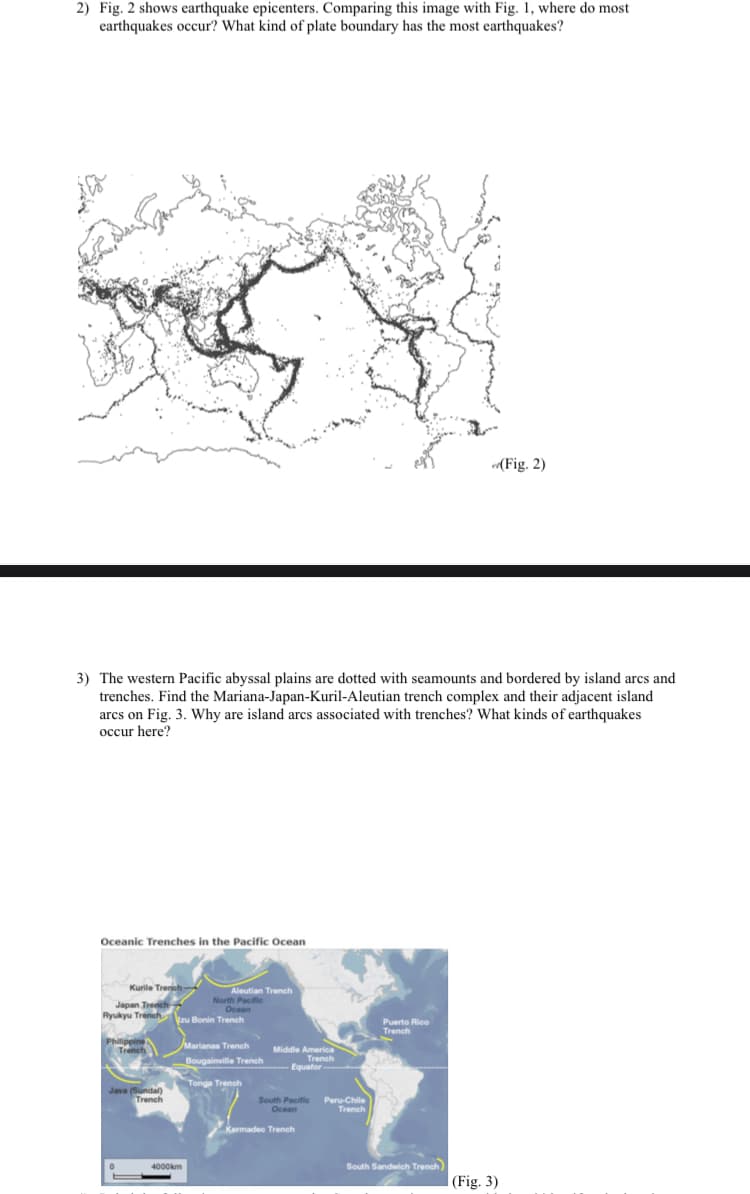ows carthquake epicenters. do most earthquakes occur? What kind of plate boundary has the most earthquakes?
ows carthquake epicenters. do most earthquakes occur? What kind of plate boundary has the most earthquakes?
Applications and Investigations in Earth Science (9th Edition)
9th Edition
ISBN:9780134746241
Author:Edward J. Tarbuck, Frederick K. Lutgens, Dennis G. Tasa
Publisher:Edward J. Tarbuck, Frederick K. Lutgens, Dennis G. Tasa
Chapter1: The Study Of Minerals
Section: Chapter Questions
Problem 1LR
Related questions
Question

Transcribed Image Text:2) Fig. 2 shows earthquake epicenters. Comparing this image with Fig. 1, where do most
earthquakes occur? What kind of plate boundary has the most earthquakes?
(Fig. 2)
3) The western Pacific abyssal plains are dotted with seamounts and bordered by island arcs and
trenches. Find the Mariana-Japan-Kuril-Aleutian trench complex and their adjacent island
arcs on Fig. 3. Why are island arcs associated with trenches? What kinds of earthquakes
occur here?
Oceanic Trenches in the Pacific Ocean
Kurile Trenh-
Aleutian Trench
Japan Trench
Ryukyu Trench
North Pacific
Ocean
zu Bonin Trench
Puerto Rico
Trench
Philippine
Marianas Trench
Middle America
Trench
Equator
Bougainville Trench
Java (Sundal) Tonga Trench
Trench
South Pacific Peru-Chile
Ocean
Trench
Kermadec Trench
4000km
South Sandwich Trench)
(Fig. 3)
Expert Solution
Step 1
Around 4.5 billion years ago earth emerged as a hot mass of gases and lava. Later by the combined action of physical, chemical and biological processes the earth cooled to form numerous features and phenomenon. By the process of condensation the waterbodies, such as oceans, seas, lakes etc. developed. Formation of the water bodies was followed by the emergence of the atmosphere and rise in oxygen level. During evolution the earth differentiated into four prominent layers, viz., the crust, the mantle and the outer and inner core.
Trending now
This is a popular solution!
Step by step
Solved in 2 steps

Recommended textbooks for you

Applications and Investigations in Earth Science …
Earth Science
ISBN:
9780134746241
Author:
Edward J. Tarbuck, Frederick K. Lutgens, Dennis G. Tasa
Publisher:
PEARSON

Exercises for Weather & Climate (9th Edition)
Earth Science
ISBN:
9780134041360
Author:
Greg Carbone
Publisher:
PEARSON

Environmental Science
Earth Science
ISBN:
9781260153125
Author:
William P Cunningham Prof., Mary Ann Cunningham Professor
Publisher:
McGraw-Hill Education

Applications and Investigations in Earth Science …
Earth Science
ISBN:
9780134746241
Author:
Edward J. Tarbuck, Frederick K. Lutgens, Dennis G. Tasa
Publisher:
PEARSON

Exercises for Weather & Climate (9th Edition)
Earth Science
ISBN:
9780134041360
Author:
Greg Carbone
Publisher:
PEARSON

Environmental Science
Earth Science
ISBN:
9781260153125
Author:
William P Cunningham Prof., Mary Ann Cunningham Professor
Publisher:
McGraw-Hill Education

Earth Science (15th Edition)
Earth Science
ISBN:
9780134543536
Author:
Edward J. Tarbuck, Frederick K. Lutgens, Dennis G. Tasa
Publisher:
PEARSON

Environmental Science (MindTap Course List)
Earth Science
ISBN:
9781337569613
Author:
G. Tyler Miller, Scott Spoolman
Publisher:
Cengage Learning

Physical Geology
Earth Science
ISBN:
9781259916823
Author:
Plummer, Charles C., CARLSON, Diane H., Hammersley, Lisa
Publisher:
Mcgraw-hill Education,